Buddhism is one of the two main religions of Ladakh and it has given Ladakh a rich architectural and cultural heritage. Because of this, a lot of tourists visit Ladakh. The monasteries of Ladakh and their annual festivals serve as a magnet for both locals and outsiders alike. During the monastery festivals, monks perform mask dances or cham.
Ladakh is dotted with monasteries dating from early 2nd millennium AD to the very recent times. The paintings of Alchi are famous throughout the world. Equally renown are the monastic festivals, the most famous being that of Hemis, the seat of power of Lama Staktsang Raspa, the royal preceptor of the erstwhile kingdom. The Basgo Palace remains a symbol of Ladakhi might and reminds us of the glory days of Ladakh. As do the castle complex of Namgyal Tsemo, built to commemorate the defeat of Turkish invaders.
These monasteries are a reminder of a time long gone by and show the architectural prowess of Ladakh and its people.
1. Hemis Monastery
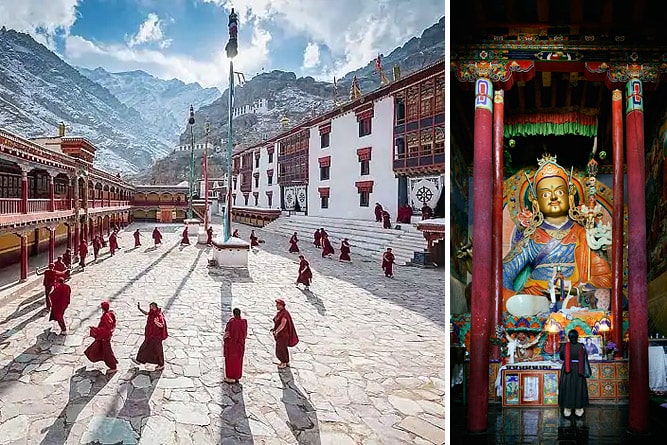
Hemis Monastery is the richest monastery of Ladakh, having been under royal and aristocratic patronage right since its inception. A simple hermitage, called Gotsang, located uphill, which is associated with the Kashmiri Buddhist Saint Naropa, the founder of Kargyud lineage of Tibetan Buddhism and his teacher Tilopa, is accessible by foot. In 1630, King Sengge Namgyal gave the estate of Hemis to Lama Stagtsang Raspa with the construction of the Tsog Khang (Meeting Hall) beginning in 1632. In 1638, the Dukhang (Main Assembly Hall) was consecrated with its frescoes. Over time, as the Drukpa sect became the preferred sect of the Ladakhi Royal Family, the monastery, being the seat of the Staktsang Raspa, became the preeminent monastery in the kingdom. Being his seat of power, the monastery and its subsidiary monasteries owned about 2000 acres of land.
The most striking feature of this monastery is its imposing façade facing the courtyard, which is dominated by the large Rabsals (wooden balconies), which are reserved for the aristocracy of the erstwhile kingdom. The main attraction of the monastery is its annual Tsechu, held in June or July, or the Hemis Festival as it is commonly known these days. Besides the above mentioned structures, there is the Lhamokhang which houses the protector deity, Paldan Lhamo. And the Guru Lakhang, which houses an imposing 8-meter-high statue of Guru Padmasambhava. Also noteworthy are the Lakhang Staktsang Raspa, Dolma Lakhang, Zabkhang and the two Zimshungs (Noble rooms) meant for the incarnate lamas and Staktsang Raspa. The large halls are richly decorated with frescoes and thangkas.
2. Alchi Monastery
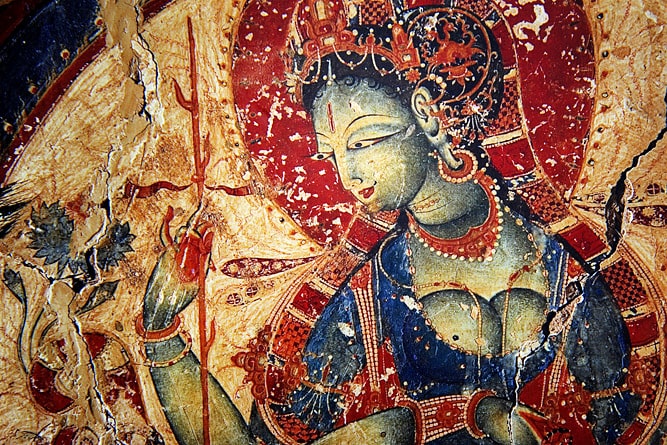
Alchi Monastery, with its exquisite murals and lavish woodwork, is the brightest of the gems that adorn the architectural heritage of Ladakh. Situated 60 km from Leh in the tranquil village of Alchi, the monastery is in fact a complex of different temples built between 11th and 13th century. Local traditions credit the building of the temples to the famous Tibetan translator Rinchen Zangpo. However, the inscriptions in the temples put the date at a later period.
The monastery comprises of 5 temples: the Sumtseg, the most breathtaking of them all, with its richly decorated interiors and unparalleled woodwork commissioned by Kalden Shesrabs in the early 13th century according to an inscription in the temple, the Jampe Lakhang dedicated to Manjushri or the Buddha of Wisdom, built around the same period, the Dukhang or the Assembly Hall dedicated to the deity Vairochana with its colonnaded veranda, the Lotsawa Lakhang or the Translators temple and the Lakhang Soma or the New Temple. The monastery is currently managed by the monks of Likir Monastery.
3. Thiksey Monastery
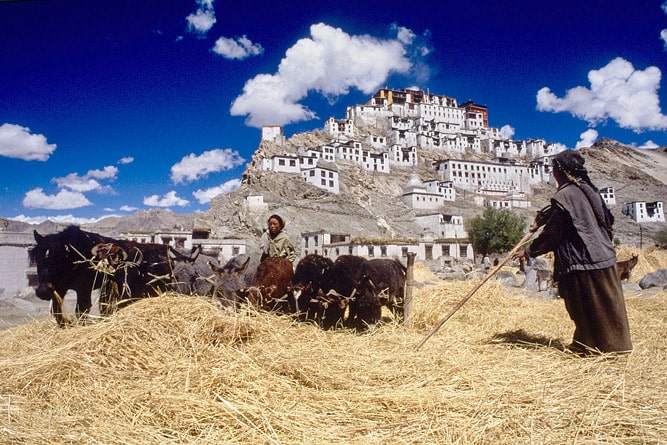
Thiksey Monastery is the largest monastery in Central Ladakh. It was built in the 15th century, immediately after the building of Stagmo monastery in 1433 by Changsems Shesrab Zangpo, one of the chief disciples of Je Tsongkhapa, the founder of Gelugpa sect of Tibetan Buddhism. Its founder was Paldan Zangpo, who in turn was one of the main disciples of Changsems Shesrab Zangpo. Over centuries, it became the chief monastery of the Gelugpa sect, owning well over 1000 acres of land. Prince Jigmet Namgyal, the half-brother of King Tsetan Namgyal, ordained as a monk at the monastery.
The monastery houses 10 temples. The main attraction is the 14-meter-high statue of Maitreya Buddha built to commemorate a visit of the 14th Dalai Lama. Apart from this, there is the Tara Temple housing the 21 forms of Goddess Tara, the Lamo-khang housing the statue of Paldan Lhamo, a protector deity, Chikhang housing the Buddha with his two chief disciples and a number of other shrines dedicated to other deities. One can also visit the Dukhang or the assembly hall which comprises the statue of Avalokiteshwara and Padmasambhava along with the seats for the Dalai Lama and the Head Lama of Thiksey. There is also a nunnery within the precincts of the monastery. As it is located on a hill, it offers a panoramic view of the Indus River and the surrounding countryside. The annual festival of the monastery known as Gustor is held from 17th to 19th of the 9th month of the Tibetan Calendar, usually in October or November.
4. Lamayuru Monastery
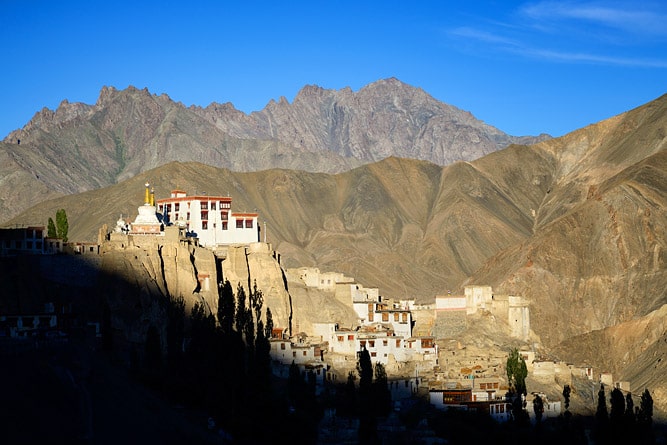
Previously known as Yungdrung, after the most popular sect in Bon religion (Shamanism), Lamayuru Monastery has changed hands twice. Before the advent of Buddhism, it was the foremost religious centre of the Bon religion. The famous Tibetan translator, Rinchen Zangpo, built the temple known as Senge Sgang, which still survives today. He also built four other rooms remains of which can still be seen. Initially, Lamayuru Monastery was under the supervision of the Kadampa sect. Later, King Jamyang Namgyal placed the monastery in the hands of Chhosrje Danma Kunga Tagspa, who was one of the leading figures of the Drigungpa sect. The monastery was thoroughly sacked by the Dogras led by Zorawar Singh in 1835. The larger structure is about four to five storey high and comprises of a Dukhang (Assembly Hall) and two richly furnished Zimshungs (Noble rooms).
The landscape around the monastery resembles a lunar landscape and is also called “moonland”. Legend has it that the place was once a lake and Indian saint Naropa caused the lake to dry up. There is also a small cave in the monastery's main prayer hall where Naropa meditated.
5. Diskit Monastery
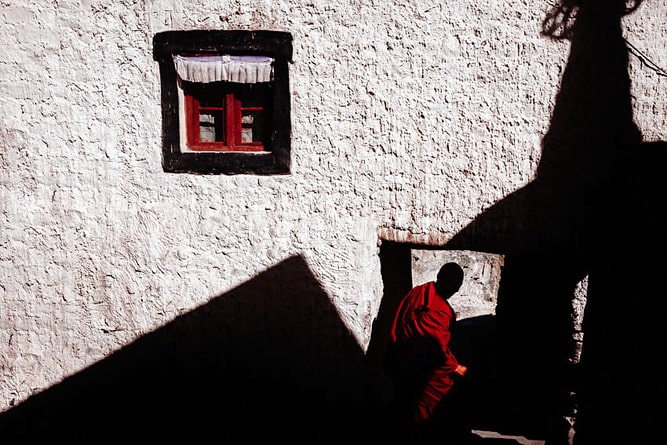
Diskit Monastery, located in the Nubra valley, shares the same founder as Thiksey Monastery, he being Changsems Shesrab Zangpo. The initial monastery was built around the same time as the Thiksey Monastery. It is administered by Khanpo Rinpochey of Thiksey. Diskit Monastery is a subsidiary of Thiksey Monastery. Legend has it that it was ransacked and destroyed by Mongol invaders but that the Protector deity of the monastery cursed a spell on them leading them to their doom. The newer monastery is said to be much bigger, having been built like a castle to ward off any invaders.
The main courtyard of the monastery is surrounded by a single storey colonnaded veranda on three sides. The monastery can be divided into three portions. The first one, which is of some historical importance, contains the old Dukhang (Assembly hall), whose walls are extensively decorated and houses a pantheon of deities, one of which holds a skull, believed to be that of a Mongol commander whom the deity had killed for plundering the monastery, and the old Zimshung (Noble room) which is reserved for the Dalai Lama. The second portion houses the new Dukhang (Assembly hall) and the new Zimshung (Noble room) which is reserved for Khanpo Rinpochey of Thiksey. The third portion, which sits at the apex, is the oldest portion of the monastery. It houses a prayer room, some rooms for the lamas to live in and a Rabsal (wooden balcony).
6. Likir Monastery
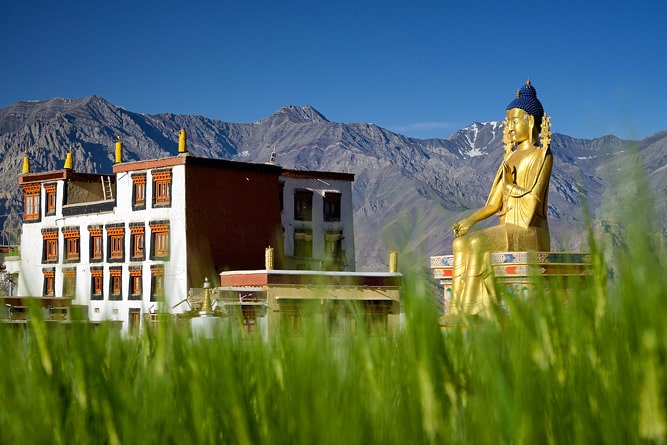
Likir Monastery was founded as a settlement of monks in the 11th century by Lama Duwang Chosje under the patronage of King Lhachen Gyalpo. It initially belonged to the Kadampa Order. In 15th century, Lama Lawang Chosje converted the monks to the Gelugpa sect and brought the monastery under its control. The monastery is situated on a small hill in a narrow valley. Its head is the Ngari Rinpochey, who is the current reincarnation is the brother of the Dalai Lama.
Likir Monastery has two Dukhangs (Assembly halls). The older one contains statues of Amitabha Buddha, Shakyamuni Buddha, Maitreya and Je Tsongkhapa, the founder of Gelugpa sect. The courtyard has a large juniper tree. The newer Dukhang houses the statue of Avalokiteshvara. The walls are richly decorated with religious paintings. Then there is the Zimshung (Noble room), the residence of the Rinpoche, which is adorned with thangkas, images and contains the twenty one manifestations of the Goddess Tara. The Gonkhang (Main Temple) houses the deities. And there is the 22-metre-high outdoor statue of Lord Buddha which is visible from miles away. The monastery is a huge repository of scriptures and manuscripts. Its annual festival Dosmochey is held from the 27th – 29th of the 12th month of Tibetan Calendar.
7. Namgyal Tsemo Fort and Gompa
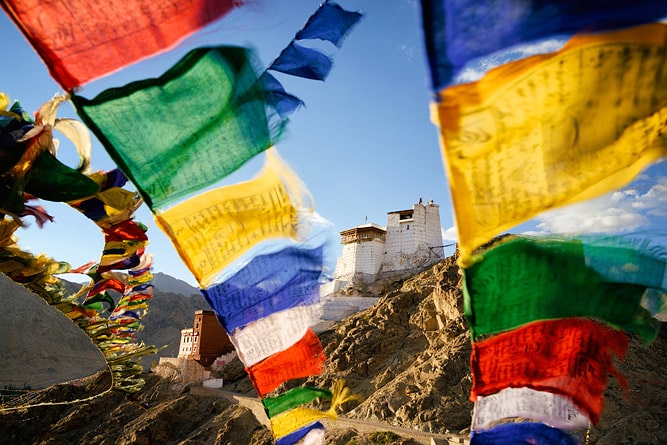
This castle complex was built by King Tashi Namgyal in the mid-16th century to commemorate his victory over the invading Turks. The summit of the hill on which it stands was named Namgyal Tsemo or the Peak of Victory. The history of the castle is closely associated with that of the Namgyal dynasty. It served as his residence when he made Leh the capital of Ladakh for the first time. It was only in the 17th century that Leh was permanently made the capital of the Kingdom of Ladakh. The complex comprises of a three-storey-high statue of Maitreya. It also houses a statue of Avalokiteshvara and the deity Paldan Lhamo which is believed to be built above the skulls of the Turks.
8. Basgo Monastery
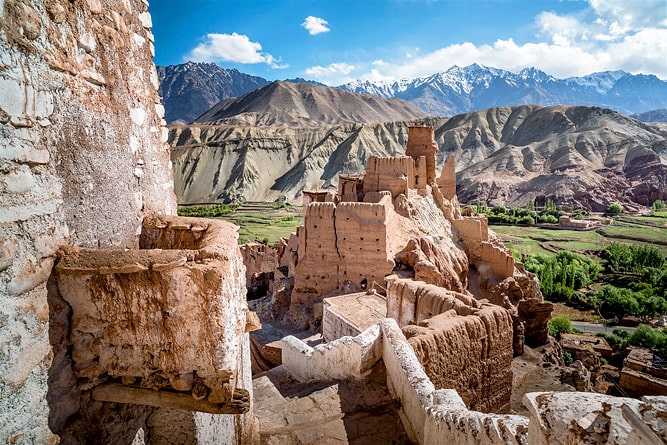
This fortress complex was built in the 15th century by King Rinchen Namgyal, the founder of the Namgyal dynasty. Additions were made by the later kings. For much of the 16th century and early 17th century, Basgo served as the capital of Ladakh. The fortress withstood a 3-year-long siege by a Tibeto-Mongol force led by a Mongol prince, Galdan Tsewang. Its fortifications were greatly admired by the Turkish commander, Mirza Haider. However, the complex was heavily damaged by the Dogras under Zorawar Singh. King Sengge Namgyal built the Serzang Chamba Temple which houses a gilded copper statue of Maitreya Buddha in memory of his father, King Jamyang Namgyal. Besides that, there is a single celled temple believed to be built by King Jamyang Namgyal for his wife, Queen Gyal Khatoon. There is also the Chamba Lakhang temple and Chamshung temple both of which are dedicated to Maitreya Buddha.
9. Chemrey Monastery
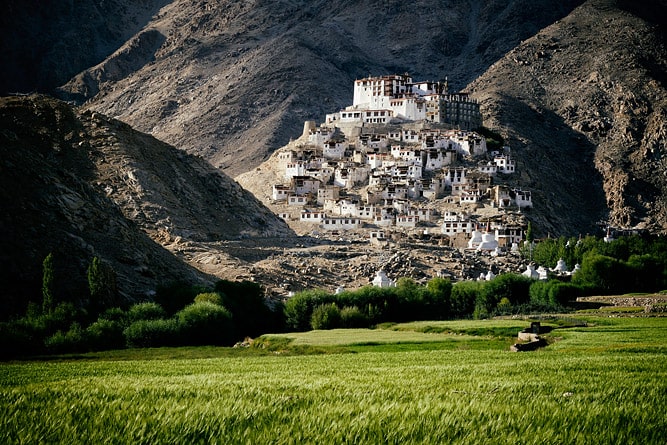
It was founded in the mid-17th century by Lama Stagtsang Raspa in memory of King Sengge Namgyal. Before its conversion to monastery, it was a palace. It was offered to Staktsang Raspa so that he could found a monastery dedicated to the late King.
Chemrey Monastery comprises of Dukhang (Assembly Hall), Gonkhang (Main Temple), Lama Lakhang, which houses the statues of the different reincarnations of Staktsang Raspa, Guru Lakhang which contains a one storey high statue of Guru Padmasambhava and the Zimshung (Noble Room), the residence of Staktsang Raspa. All these rooms are richly adorned with frescoes and paintings. Besides them, a museum has been created by converting a small portion of the monastery. This houses traditional and religious artifacts, and some traditional objects of daily use. The annual festival called Aangchhok takes place on 28th and 29th of the 9th month of the Tibetan Calendar.
10. Rizong Monastery
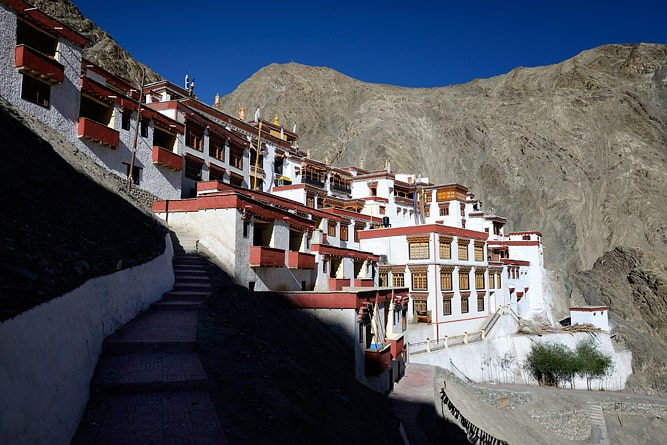
Rizong Monastery was built by Lama Tsultim Nyima around the time of the Dogra invasion. It is also known as Yuma Changchubling. The monastery is known for its strict code of discipline followed by its monks. The monastery belongs to the Gelugpa sect. It is administered by Galdan Thrizur Sras Rinpochey, the nephew of the 19th Bakula Rinpoche. He is the only Ladakhi to have ever ascended the throne of Galdan, the most prestigious rank in the Gelugpa sect. The monastery comprises of Dukhang (Assembly Hall), Chokhang, two Zimshungs (Noble Room), Skudung (Relic Shrine) and Lakhang (Deity Temple). The Dukhang contains a statue of Lord Buddha, a statue of a previous incarnation of Sras Rinpoche, a statue of Avalokiteshvara and some important deities. It is richly decorated with frescoes. The Chokhang contains the statue of Jowo Rinpoche, hence its name. It also contains a statue of Avalokiteshvara, Maitreya Buddha and a silver Changchub Stupa. The Skudung contains the relics of Lama Tsultim Nyima, the founder of the monastery. The Lakhang contains the statues of deity Paldan Lhamo, Lama Tsultim Nyima and his 2nd incarnation.
Two kilometres from the monastery lies the Chulichan Nunnery surrounded by apricot orchards. The nuns who reside here are provided for by the monastery.
When can these Buddhist monasteries be visited?
Namgyal Tsemo Gompa can be visited when you are in Leh. It is walkable distance from the city centre.
Hemis Monastery, Thiksey Monastery and Chemrey Monastery are included in the 1-day monastery tour. These monasteries can also be visited during the Pangong lake tour.
Alchi Monastery, Lamayuru Monastery, Likir Monastery, Basgo Monastery and Rizong Monastery are part of the Sham tour. The tour is usually done in 2 or 3 days and the itinerary can also include the Dha-Hanu valley and Kargil in western Ladakh. The monasteries can also be visited on the first day of the trip from Leh to Srinagar.
Diskit Monastery is included in the Nubra valley tour.
